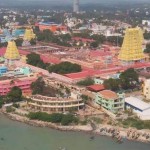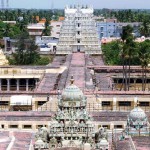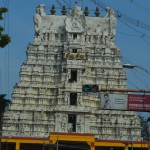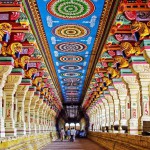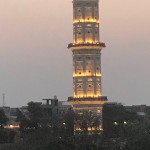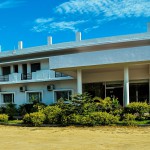| Rameshwaram City |
| About: |
| Rameshwaram is an island situated in the gulf of manner at the very tip of the IndAccording to a legend, Rama worshiped Shiva in the form of a Shiva Lingam, while returning to Ayodhya. This lingam was made of earth by Rama’s consort, Sita. It is also said that Hanuman was sent to bring an image of Viswanathar from Banares. Rama thought that Hanuman will be late in returning. Therefore, Rama is said to have offered worship at a pre-chosen auspicious moment to the Shivalingam. This lingam is referred to as Ramalingam. ian peninsula.A very important pilgrim centre of the Indians. Rameshwaram is the place from where Lord Rama, built a bridge across the sea to rescue his consort Sita, from her abductor, Ravana. This is also the place where Rama worshipped Lord Shiva to cleanse away the sin of killing Ravana. Both the Vaishnavites and Shaivites visit this pilgrimage which is known as the Varanasi the south.Rameshwaram is significant for the Hindus as a pilgrimage to Benaras is incomplete without a Pilgrimage to Ra Rameshwaram is significant for the Hindus. The presiding deity is the Linga Of Sri Ranganatha, which happens to be one of the twelve Jyotirlingas of India. Rameshwaram is popularly referred as the ‘Benaras of the south’. In order to attain Moksha it is believed that a visit to Rameshwaram is mandatory. In fact the entire area of Rameshwaram is associated with various incidents from the Ramayana. The city of Rameshwaram happens to be one of the most visited pilgrim sites in India.The places of visit include the Ramanathaswamy Temple, which was built in the 17th century and is situated close to the sea on the eastern side of the island; this temple is famous for its 1200 gigantic granite columns. At a distance of about 100 metres comes the Agnitheertham, where Rama worshipped Lord Shiva, to absolve himself from the killing Ravana.Another shrine called Gandamadana Parvatham is worth visiting. This shrine is found at 2kms away from Rameshwaram. A place called Dhanushkodi named after Rama’s bow is at the eastern end of the island at a distance of 8 kms from Rameshwaram.According to a legend, Rama worshiped Shiva in the form of a Shiva Lingam, while returning to Ayodhya. This lingam was made of earth by Rama’s consort, Sita. It is also said that Hanuman was sent to bring an image of Viswanathar from Banares. Rama thought that Hanuman will be late in returning. Therefore, Rama is said to have offered worship at a pre-chosen auspicious moment to the Shivalingam. This lingam is referred to as Ramalingam.Rameshwaram. The presiding deity is the Linga Of Sri Ranganatha, which happens to be one of the twelve Jyotirlingas of India. Rameshwaram is also popularly referred to as the ‘Benaras of the south’. In order to attain Moksha it is believed that the visit to Rameshwaram is mandatory. |
| The religious island is spread in an area of 61.8 square kilometers and happens to be in the shape of a conch. The Ramanatha Swamy Temple occupies major area of Rameshwaram. The masterpiece of Dravidian architecture boasts of the largest temple corridor in India. Different rulers built the Ramanatha Swamy Temple over a period of time starting from the 12th century. The temple comprises of twenty-two wells where the taste of the water of each well is different from the other. |
| Location info: |
| Rameshwaram City,Rameshwaram Districts ,Tamil Nadu,India |
| Climate/Weather of Rameshwaram City: |
| Summer:Max :98 C, Min : 46C,Winter: Max : 30C, Min : 25C |
| History of Rameshwaram City: |
| The Hindu mythology says that in the story of Ramayana, Lord Rama performed thanksgiving rituals to Lord Shiva after the battle at Sri Lanka and his triumph over the demon king Ravana. This is the reason why Rameshwaram attracts Vaishnavites (worshippers of Lord Vishnu) and Saivites (worshippers of Lord Shiva) both. The entire area of Rameshwaram is associated with various incidents from the Ramayana. Infact Rameshwaram is one of the most visited pilgrim sites in India.The bridge took 14 years to build and was opened by Rajiv Gandhi late in 1988. The town lies on the island’s eastern side and used to be the port from which the ferry to Talaimannar (Sri Lanka) departed before normal passenger services were suspended more than a decade ago. As a result, there are now very few foreign visitors. |
| Educational Institutions of Rameshwaram City: |
| Arts & Science: Govt. Arts College for Women, Ramanathapuram Govt. Arts College, Paramakudi Madurai Kamaraj University Evening College, Paramakudi Madurai Kamaraj University Evening College, Ramanathapuram Sethupathy Govt. Arts College, Ramanathapuram Caussanel College of Arts and Science, Ramanathapuram Pasumpon Thiru. Muthuramalinga Thevar College, Ramnad Sonai Meenal Arts and Science College, Mudukulathur Syed Hammeda Arts and Science College, Kilakkarai Thassim Beevi Abdul Kadar College for Women, RamnadHotel Management: Govt. Arts College for Women, Ramanathapuram Kings Institute of Catering and Hotel Management, Ramnad Thassim Beevi Abdul Kadar College for Women, RamnadEngineering: Syed Ammal Engineering College, Ramanathapuram Anna University Tiruchirappali, Ramanathapuram Campus, Ramanathapuram Ganapathy Chettiar College of Engineering and Technology, Paramakudi Mohamed Sathak Engineering College, KilakaraiManagement: Government Arts College, Paramakudi Mohamed Sathak Engineering College, Kilakarai The Thassim Beevi Abdul Khader College for Women, KilakaraiPolytechnic: Mohammed Sathak Polytechnic, Keelakari Sri Muthalamman Polytechnic College, ParamakudiPhysiotherapy: Pioneer College of Physiotherapy, RamanathapuramTTI: C.S.I. College of Education, Ramanad Fatima Teacher Training Institute, Ramanathapuram Ganapathi Teacher Training Institute, Paramakudi Ganapathy College of Education, Paramakudi Meds Teacher Training Institute, Ramanathapuram Puratchi Thalaivar Dr. M.G.R. College of Education, Ramanathapuram R.K. Samy College of Education, Ramanathapuram R.K. Samy Teacher Training Institute, Ramanathapuram Sri Ragavendra Institute of Teacher Training, Paramakudi Theivika Thirumughan Pasumpon Thevar T.T.I., Kamuthi |
| Langauge |
| Tamil Langauge |
| Culture: |
| The culture is a mixture of Tamil Nadu and Kerala. Christianity, Hinduism and Islam are the main religions practiced, with Christians accounting to nearly half of the populace. Some of the communities in the district are Nadars, Nanjil Nadu Vellalars, Paravas, Mukthavas, Vilakki Thalanayar, Kammalar or Asari, Chackarevars, Kerala Mudalis etc.Fairs:The festivals of Dharmapuri are varied and add an extra spark of life to the town’s daily lives. Notable among.Festivals:Pongal :Like all the other regions of Tamil Nadu, Pongal is one of the most important festivals of Dharmapuri. Mahashivaratri :If you are planning a tour to Dharmapuri, one of the best times to visit would be during February when the festivities of Mahashivaratri promise to add a dash of special flavor to your vacation.Bow Song: This is locally known as Villu Pattu. It is an ancient form of musical – story – telling art of southern Tamil Nadu. This art is famous particularly in Southern Tamil Nadu.Bow or the age-old weapon of warriors paradoxically lends itself to be used as a primary musical instrument for the Villu Pattu artists. Some of the important instruments that are used in these performances can be mentioned as follows Udukku, Kudam, Thala-Kattai etc. Udukku is mentioned in the ancient Tamil literature and it is described as Thudi, which is a small drum with a slender middle portion that is held in the left hand and played by the fingers of the right hand.This may be seen in the pictures and statues of Lord Nataraja also. Sometimes the Villu Pattu team divides itself into two groups, each trying to prove opposite view points of a subject by conducting the programme by exchange of questions and answers. This is called Lavani Pattu. The songs used by the Villu-Pattu artists are mostly traditional folk songs. This art is transformed by generation after generation. In today`s world folk art is regarded as most ethnic one and this is perfectly transmitted by bow song.Kalial: This is a folk dance played by group of men or boys in the countryside. A group leader sings songs and keeps time with cymbals. The players stand in a circle with sticks in their hand and dance round a lighted lamp repeating the songs sung by the leader. In course of time they turn, twist, lean forward and backward, squat and move round singing to the tune. At the beginning the steps are elaborate and at times, they are also very quick. When invited to perform in a function, the players generally begin the dance with an invocation for heavenly aid and conclude the dance with a torch -dance using lighted torches. This folk dance exhibits the artistic and recreative life of the countryside a swell. This dance is very refreshing to perform as well as to enjoy.Kathakali Kathakali: This is a unique form of drama, which has its origin in Travancore. Kathakali or story-dance is a relatively recent development of earlier dances. This happened during fifteenth or sixteenth century. This dance form arose out of religious expression through symbolical action. In this art form, the characters express their ideas not by words, but by significant gestures. Like eye movement, lip movement, etc. The movements are adopted from the Bharatha Natya with suitable modifications. The Bhagavathar recites the conversations between the characters as well as the narrative portion of the story in a loud voice. This is always accompanied by musical instrument. All these conversations should invariably be in verse. The action is promoted by his words.The costume and make up of the actor are also important aspects in Kathakali. There are standard make up for the different types of actors. Mainly red, yellow, green, black and white are the colours used in this art form. The headdresses are made of lightweight wood and are decorated with pieces of mirror, spangles, and colored stones. Usually, a Kathakali performance extends from eight to ten hours. With the advent of the cinema, the popularity of this art has declined. It is now played in the temples at Thiruvattar, Thirparappu, Ponmana, Kuzhithurai, Neyyoor and Munchira in the Kanyakumari District twice a year during the time of festivals. But this art form is popular worldwide and people from different parts usually come to see the presentation.Karagam Dance: This is a kind of dance common in the countryside. Both men and women play it during the time of festivals and marriages. This is very popular and people perform it with full of joy and energy.Kalari: This is also known as Adimurai in Kanniyakumari district. This is an ancient martial art, which is still preserved in the villages of this district and also in Kerala. A tradition believed to have been founded by Paraurama is known Vadakkan Kalari. |
| How to reachRameshwaram City? |
| Nearest Railway Station:Rameshwaram railway station (3kms from the city). It is connected by several trains with major cities of Tamil Nadu like Chennai, Madurai, Coimbatore, Tiruchirapalli and other places in South India. Sethu Express, Tirupati-Madurai Express, Tirunelveli Express, Rameshwaram Express, Rameshwaram -Coimbatore Fast Passenger are the major trains that connects Rameshswaram. From railway station one can hire local transport like cycle, auto-rickshwas, jeeps and taxis etc. |
| Nearest Airport:Madurai airport at 174km |
| Road Transport:Rameswaram is well connected to all the main towns. The Pamban Bridge has made Rameshwaram accessible by road from other parts of the South via the NH 49. There is a regular bus service from Kanniyakumari, Madurai (Routes from Madurai – NH49 to Rameswaram via Ramanathapuram from Trichy NH210 to Ramanathapuram via Karaikkudi; NH49 to Rameswaram via Mandapam), Trichy, Tiruchendur and Madras to Mandapam. Rameshwaram is 527 km from Chennai, 315 km from Kanyakumari and 273 km from Tiruchirapalli |
| Tourist Attraction of Rameshwaram City: |
| Ramanathaswamy Temple: The legend says that Hunuman was sent by Lord Rama to bring a temple_tower1.jpg (205360 bytes)Lingam to worship at an appointed auspicious hour. As Human’s arrival was delayed, Sita moulded a lingam for Rama’s timely worship. It is the main deity being worshiped as Ramanathaswamy. Disappointed Hunuman was later consoled by Rama by installing the Lingam which was brought by him a little north of Ramanatha, and decreed that the Hunuman’s lingam should have precedence over the Ramanatha in all honours.Annai Indira Gandhi Bridge: The 2.2 km. length bridge connecting the Rameswaram Island and the mainland is the longest bridge in India constructed over a bay. It is also called as Pamban Bridge. Similarly the railway bridge connecting the island is noted for its unique opening to pass the ships through the sea.Mandapam & Pamban: Lying on the Ramanathapuram Rameswaram National Highway and just 19 kms before Rameswaram lies this sleepy coastal village of Mandapam . Prior to the 1914 train service linking the mainland with Rameswaram, boats were the only mode of transport to ship the pilgrims on their journey to Rameswaram. It is possible to take a boat for a cruise through the mangrove marshes to Kurusadai Island.Villoondi Theertham: Villoondi literally translated stands for ‘buried bow’. It is quite well known that Lord Ram always carried a bow. According to legend, at this sacred spot, located around 7 kilometers from the main temple on the way to Pamban, is this puranic place, significant because it was at this place where Lord Ram is said to have quenched the thirst of Sita by dipping the bow into the sea water. Even to this day, tourists throng this place to see where potable water is available within the vicinity of sea water.Agnitheertham: The calm shallow water-spread of the sea, present hardly 100 meters in front of the temple gopuram is considered as sacred. A dip in the Agnitheertham is considered to remove the sins of the pilgrims. The other theerthams (holy water tanks) in and around the temple are also important for Pilgrims.Badrakali Amman Temple: A kilometer away from the main sanctum sanctorum is the Badrakali Amman Temple with Devi Durga as its chief deity. It is very popular among Devi Durga’s worshippers hailing mainly from West Bengal & Kolkatta. This temple is en-route the Gandhamathana Parvatham.Kothandaramaswamy Temple: Kothandaramaswamy Temple This Vishnu shrine is located 18 kms away on the southern tip of the island called Dhanushkodi.This temple is the only structure that survived the 1964 cyclone which washed away the rest of Dhanushkodi.It can be reached by road from Rameswaram and buses ply to this place. It was the place where Vibishana the brother of Ravana is said to have surrendered to Rama.The temple has beautiful idols of Rama, Sita, Lakshmana, Hanuman and Vishnu. On the very tip of Dhanushkodi is a sacred pool – a lovely bathing ghat.The Gandhamadana Parvatham (Hillock): The Gandhamadana Parvatham (Hillock) It is in the north –west of the island and the most elevated point of the island. It is a two-storied structure with a ruined fort. Hanuman is said to have leapt from this point across the sea to reach Lanka.The feet of Rama is in the centre of the lower storey. It is also known as Ekantha Rameswaram and contains handsome idols of Rama, Sita and Lakshmana.Here; Rama is seen raising one of his arms. From this elevated place, one can have an excellent view of the whole island.Coral Reefs: The coral reefs of Rameswaram are another attraction mainly for marine biologists, who throng these islands for research and observation.Dhanushkodi: The southernmost tip of the island is called Dhanushkodi. It was completely washed away by a cyclone in 1964. But the Kothandaramasamy Temple here remains intact. It is 18 KMs way from Rameswaram can be reached by road. A popular belief is that, it is where Vibishana a brother of Ravana surrendered before Rama. Dhanushkodi has a fine beach, where Sea surfing is possible.Devi patinam: A coastal village is also known as Navashabashanam.It is believed that Lord Rama worshipped Navagraha here. The temple near by here, is dedicated to Devi, who is said to have killed the demon Mahishasura at this spot. Hindus perform religious rites for their forefathers here.Erwadi: The tomb of Sultan Ibrahim Syed Aulia, who came from Arabia via Cannanore is about 800 years old. Pilgrims from far off countries like Srilanka, Malaysia and Singapore are visiting this tomb. Santhanakoodu Festival is celebrated in February-March attracts thousands of pilgrims.Satchi Hanuman Temple: This is where Hanuman said to have delivered the good news of sita’s well being to Rama with an evidance choodamanai(Jewel) of Sita.Five Faced Hanuman Temple: Hanuman is adorned with senthooram here. The stone said to have used to construct the floating bridge Sethu Bandanam could be seen here.Thiruvetriyur: The Patham Priya Koil is situated in Thiruvetriyur in R.S. Mangalam Block of the district. The temple is spread over a vast area and has a large Tank and pilgrims flock here in hundreds every day for blessings and to pay obeisance.Sethu karai: A place of Puranic importance, Sethu karai (meaning the Sethu Coast) is an important pilgrim centre having religious significance owing to the belief that Lord Ram is said to have constructed a bridge from here over the sea waters to reach Sri Lanka . It is a hallowed place for Hindus as they conduct their religious rites in this place and is situated around 68 kilometers from Rameswaram and is near Erwadi Dharga.Oiyur: Oriyur is one of the most revered pilgrim centers for Christians the world over as it is home to the martyrdom of St. John De Britto, a Portugese Jesuit better known as ‘Arul Anandar’. It was in this place that the saint was beheaded in 1693 and the sand dune is said to have turned red, believed to be stained by the blood of the saint. Here, one can see a magnificent shrine with its Portugese façade that contains a captivating statue of Arul Anandar offering his neck in humble submission to the executioner.Sea world aquarium: Just opposite the Rameswaram Bus Stand, one can catch a quick glimpse of an assortment of underwater creatures in their near natural habitat in the ‘Sea World Aquarium’ – the only one of its kind in the state, and probably in the country too, filled with such varied marine life forms including exotic species such as Octopus, Snake fish, Parrot fish, Sea lizard, Sea squid, Cow fish, Lion fish, Rabbit fish, Fire fish, Butter fish, Clown fish, Crabs, Lobsters, Prawns, Sea Lotus, Beach Tamet, Star Fishes, Sea Horses and Sharks. This is quite an eye-opener for young tourists & kids and lovers of marine life. |
| Hotels/Lodge/Accommodation in Rameshwaram City: |
| Hotel Hare Rama Hare Krishna:15/24, Ramar Padham Road,Thittakudi St, Rameswaram,Tamil Nadu,India,Ph:04573 223500Hotel Shanmuga Paradise:Opp temple,no.10/98, Middle St,Rameswaram,Tamil Nadu,India,Ph:04573 222945Maharaja Hotel:Near The Temple,No.7,Middle Street,Rameshwaram,Tamil Nadu,India,Ph:04573 221271 |
| Links: |
| http://www.allindia-travel-tours.com/south-india-cities/rameshwaram.html |
